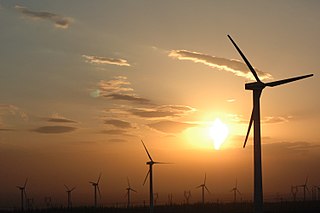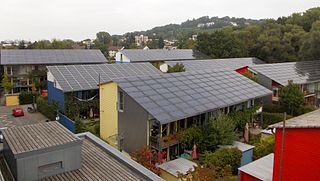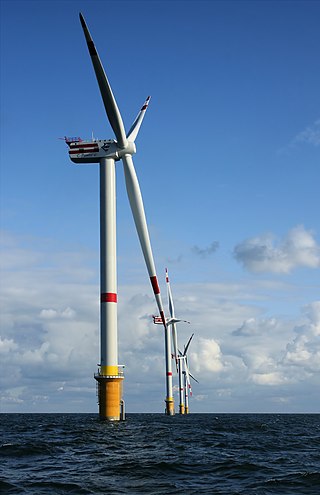Related Research Articles

Wind power is the use of wind energy to generate useful work. Historically, wind power was used by sails, windmills and windpumps, but today it is mostly used to generate electricity. This article deals only with wind power for electricity generation. Today, wind power is generated almost completely with wind turbines, generally grouped into wind farms and connected to the electrical grid.

Energy development is the field of activities focused on obtaining sources of energy from natural resources. These activities include the production of renewable, nuclear, and fossil fuel derived sources of energy, and for the recovery and reuse of energy that would otherwise be wasted. Energy conservation and efficiency measures reduce the demand for energy development, and can have benefits to society with improvements to environmental issues.

A wind farm or wind park, also called a wind power station or wind power plant, is a group of wind turbines in the same location used to produce electricity. Wind farms vary in size from a small number of turbines to several hundred wind turbines covering an extensive area. Wind farms can be either onshore or offshore.

Risø DTU National Laboratory for Sustainable Energy is a scientific research organization north of Roskilde, Denmark.
Emergy is the amount of energy consumed in direct and indirect transformations to make a product or service. Emergy is a measure of quality differences between different forms of energy. Emergy is an expression of all the energy used in the work processes that generate a product or service in units of one type of energy. Emergy is measured in units of emjoules, a unit referring to the available energy consumed in transformations. Emergy accounts for different forms of energy and resources Each form is generated by transformation processes in nature and each has a different ability to support work in natural and in human systems. The recognition of these quality differences is a key concept.

Sustainable architecture is architecture that seeks to minimize the negative environmental impact of buildings through improved efficiency and moderation in the use of materials, energy, development space and the ecosystem at large. Sustainable architecture uses a conscious approach to energy and ecological conservation in the design of the built environment.
A wind power forecast corresponds to an estimate of the expected production of one or more wind turbines in the near future, up to a year. Forecast are usually expressed in terms of the available power of the wind farm, occasionally in units of energy, indicating the power production potential over a time interval.
Specialized wind energy software applications aid in the development and operation of wind farms.

Community wind projects are locally owned by farmers, investors, businesses, schools, utilities, or other public or private entities who utilize wind energy to support and reduce energy costs to the local community. The key feature is that local community members have a significant, direct financial stake in the project beyond land lease payments and tax revenue. Projects may be used for on-site power or to generate wholesale power for sale, usually on a commercial-scale greater than 100 kW.
This page is an index of sustainability articles.
Wind resource assessment is the process by which wind power developers estimate the future energy production of a wind farm. Accurate wind resource assessments are crucial to the successful development of wind farms.

A wind turbine is a device that converts the kinetic energy of wind into electrical energy. As of 2020, hundreds of thousands of large turbines, in installations known as wind farms, were generating over 650 gigawatts of power, with 60 GW added each year. Wind turbines are an increasingly important source of intermittent renewable energy, and are used in many countries to lower energy costs and reduce reliance on fossil fuels. One study claimed that, as of 2009, wind had the "lowest relative greenhouse gas emissions, the least water consumption demands and the most favorable social impacts" compared to photovoltaic, hydro, geothermal, coal and gas energy sources.
The Wind Energy Data and Information (WENDI) Gateway was established by the Environmental Sciences Division of Oak Ridge National Laboratory in March 2010 to support the United States Department of Energy's Wind and Hydropower Technologies Program. It provided a digital library for wind energy-related data and information from a wide spectrum of sources—including data centers, scientific and technical journals, and geographic information systems (GIS), as well as the websites of government agencies, corporations and trade organizations. The gateway was taken offline after funding ended in August 2012. Much of its content was incorporated into the OpenEI site.
The following outline is provided as an overview of and topical guide to wind energy:

Wind power in Thailand amounted to an installed production capacity of 224.5 MW as of the end of 2014. Installed capacity was 112 MW at the end of 2012, with 111 MW added in 2013, and a minor amount added in 2014. This ranked Thailand 46th in the world by installed capacity as of 2015.
Energy modeling or energy system modeling is the process of building computer models of energy systems in order to analyze them. Such models often employ scenario analysis to investigate different assumptions about the technical and economic conditions at play. Outputs may include the system feasibility, greenhouse gas emissions, cumulative financial costs, natural resource use, and energy efficiency of the system under investigation. A wide range of techniques are employed, ranging from broadly economic to broadly engineering. Mathematical optimization is often used to determine the least-cost in some sense. Models can be international, regional, national, municipal, or stand-alone in scope. Governments maintain national energy models for energy policy development.
Meteodyn WT, commonly known as Meteodyn is a wind energy software program that uses computational fluid dynamics (CFD) to conduct wind resource assessment. Developed and marketed by Meteodyn, Meteodyn WT was first released in September 2009. The software quantifies the wind resource in a desired terrain in order to assess the feasibility of a proposed wind farm. The software's objective is to design the most profitable wind farm. This is achieved by taking into account the measured wind data at a measurement tower and the terrain conditions. Both of these are essential to be able to obtain the wind conditions and therefore the wind resources of the desired terrain.

IDA IndoorClimate andEnergy is a Building performance simulation (BPS) software. IDA ICE is a simulation application for the multi-zonal and dynamic study of indoor climate phenomena as well as energy use. The implemented models are state of the art, many studies show that simulation results and measured data compare well.

The Global Wind Atlas is a web-based application developed to help policymakers and investors identify potential high-wind areas for wind power generation virtually anywhere in the world, and perform preliminary calculations. It provides free access to data on wind power density and wind speed at multiple heights using the latest historical weather data and modeling, at an output resolution of 250 meters. It is owned and maintained by the Wind Energy Department of the Technical University of Denmark and in recent years has been developed in close partnership with the World Bank, with funding provided by the Energy Sector Management Assistance Program (ESMAP).
WindStation is a wind energy software which uses computational fluid dynamics (CFD) to conduct wind resource assessments in complex terrain. The physical background and its numerical implementation are described in. and the official manual of the software.
References
- ↑ Sveinbjornsson, Stefan Kari (25 July 2013). "Analysis of WAsP (Wind Atlas Analysis and Application Program) in complex topographical conditions using measured production from a large scale wind farm". University of Washington.
{{cite journal}}: Cite journal requires|journal=(help) - ↑ "European Wind Atlas" . Retrieved 31 December 2016.
- ↑ "WAsP home page, DTU Wind Energy" . Retrieved 31 December 2016.
- Balo, Figen; Yilmaz, Unal; Sua, Lufta S. (2021). "Energy Efficiency and Sustainability through Wind Power for Green Hospitals". In Ting, David S. K.; Stagner, Jacqueline A. (eds.). Sustainable Engineering for Life Tomorrow. Lexington Books. pp. 79–81. ISBN 9781793625021.
- Nelson, Vaughn (2009). Wind Energy: Renewable Energy and the Environment. CRC Press. pp. 54, 58, 192. ISBN 9781420075694.
- Tandıroğlu, Ahmet; Çetin, Murat (2014). "Wind Energy Resource Assessment of Ergan Mountain Ski Center, Erzincan Turkey". In Midilli, Adnan; Kucuk, Haydar; Dincer, Ibrahim (eds.). Progress in Exergy, Energy, and the Environment. Springer International Publishing. pp. 834–835. ISBN 9783319046815.
- Tang, Xiao-Tu (2022). "Optimizing Wind Farm Layouts". In Stoevesandt, Bernhard; Schepers, Gerard; Fuglsang, Peter; Sun, Yuping (eds.). Handbook of Wind Energy Aerodynamics. Springer International Publishing. p. 1245. ISBN 9783030313074.